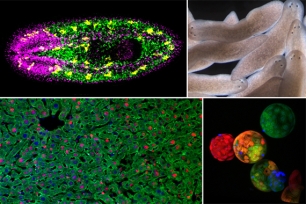Flatworms yield insights into the mystery of regeneration

(Top) Adult planarian flatworms are typically six millimeters long. Chop them in half and you'll get two new animals. Chop them into twenty pieces, and you'll get twenty new animals.
(Bottom) Planarian neoblasts, or stem cells, are shown here in red. While they are technically adult stem cells, they are as versatile as embryonic stem cells.
Images courtesy of Reddien lab.
CAMBRIDGE, Mass. (November 21, 2005) — If you take a planarian flatworm and chop it in half, something extraordinary happens: One section grows a new head, the other a new tail, and soon you have two new flatworms. Chop it into quarters, or eighths, and you'll notice the same thing. For centuries scientists have puzzled over this biological phenomenon, but only recently have they understood that these creatures are a goldmine for exploring how stem cells regenerate damaged tissue. Now, scientists at Whitehead Institute for Biomedical Research and University of Utah School of Medicine have begun to understand the biological processes of how the planarian flatworm achieves in itself what scientists hope to one day accomplish in the clinic: complete regeneration of damaged tissue.
"This paper is a starting point for investigating the cellular basis of regeneration," says Whitehead Associate Member Peter Reddien, lead author on the paper that will appear in the November 25 issue of the journal Science.
The human anatomy is no stranger to regeneration. If you think about all the times you have cut and scraped your hands, it's amazing how intact they are. Even more dramatic is the human liver: Remove a chunk and it grows back. Researchers hope to one day harness the power of stem cells to regenerate, say, heart tissue, or pancreatic tissue, or nerve tissue. But at the moment, regeneration is still one of biology's greatest black boxes.
Enter the planarian flatworm.
One is hard pressed to find in nature a more dramatic example of regeneration. You can even cut a planarian slice as small as 1/279th of the animal and still have it turn into a complete adult. And while the planarian anatomy is much simpler than that of higher mammals, they still have differentiated tissue such as skin, intestine, musculature and brain. These organs are maintained — and recreated — by planarian neoblasts, a kind of stem cell that shares characteristics with both adult and embryonic stem cells. Like adult stem cells, neoblasts are located in adults with mature tissue. But like embryonic stem cells, they may be capable of turning into any kind of cell type in the body.
"Planarians have solved exactly what people want to accomplish with regenerative medicine," says Reddien, who is also an associate professor of biology at MIT. "This has been worked out by evolution." The question, of course, is how.
In May of 2005, Reddien and his then-colleagues at University of Utah completed the first high-throughput RNA interference screen of planarian genes, with results published in the journal Developmental Cell. The researchers painstakingly silenced 1,065 genes one at a time with RNAi techniques, and found 204 genes of interest that had corresponding genes in other species, including humans.
One of these genes, called smedwi-2, stood out. When smedwi-2 was disabled, the flatworm was suddenly unable to regenerate at all, and its body curled into a stationary, irregular position. (This set of defects was similar to that of animals in other experiments in which all the stem cells in the planarian were killed with irradiation.) This raised an obvious question: Exactly how does smedwi-2 control the planarian's ability to regenerate?
"The question is significant," says Alejandro Sanchez Alvarado, Professor of Neurobiology and Anatomy at the University of Utah School of Medicine and senior author on the paper. "Smedwi-2-like genes are found throughout nature, from plants to humans. In fact, a homolog of this gene is found in human blood stem cells."
As reported in Science, the team discovered that smedwi-2 does not regulate the stem cells themselves, but rather it controls cells produced by stem cells.
When a stem cell divides in two, one of the daughter cells is a stem cell, and the other is a cell whose function can be to replace a specific type of cell. When smedwi-2 is disabled, however, this second group of cell types can't carry out its function. Smedwi-2 regulates regeneration through overseeing and enabling the reparative activity of these cells. The precise mechanism by which they do this is unclear. Still, this paper marks the first instance in which a planarian gene has been studied at this level of resolution.
"Planarians provide us with a new paradigm to study the function of stem cells," says Sanchez Alvarado, who is also a Howard Hughes Medical Institute investigator. "The mechanisms that are found in this animal are likely to be conserved in the regulation of stem cells in higher organisms like us."
"This gives us some answers about how stem cells are controlled in planarians, and it's starting to hit at the basic science of stem cells," says Reddien. "It also has a broader application for understanding the biology of regeneration. We're still at the very beginning of the basic science phase, but this is a good start."
This research was funded by the National Institutes of Health and by the Helen Hay Whitney Foundation.
***
Reddien, P. W., et al. (2005). SMEDWI-2 Is a PIWI-Like Protein That Regulates Planarian Stem Cells. Science, 310(5752), 1327-1330. doi:10.1126/science.1116110
Topics
Contact
Communications and Public Affairs
Phone: 617-452-4630
Email: newsroom@wi.mit.edu


